Related Research Articles
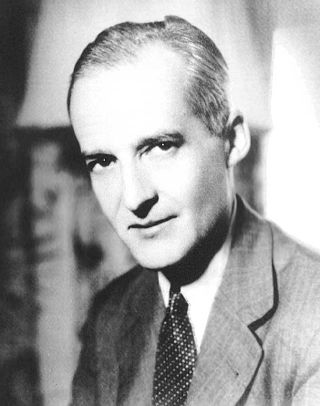
Luis Federico Leloir was an Argentine physician and biochemist who received the 1970 Nobel Prize in Chemistry for his discovery of the metabolic pathways by which carbohydrates are synthesized and converted into energy in the body. Although born in France, Leloir received the majority of his education at the University of Buenos Aires and was director of the private research group Fundación Instituto Campomar until his death in 1987. His research into sugar nucleotides, carbohydrate metabolism, and renal hypertension garnered international attention and led to significant progress in understanding, diagnosing and treating the congenital disease galactosemia. Leloir is buried in La Recoleta Cemetery, Buenos Aires.

The University of Buenos Aires is a public research university in Buenos Aires, Argentina. It was established in 1821. It has educated 17 Argentine presidents, produced four of the country's five Nobel Prize laureates, and is responsible for approximately 40% of the country's research output.
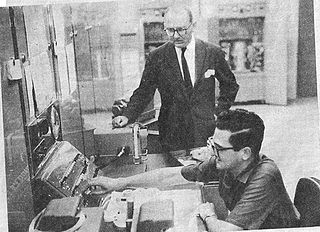
Manuel Sadosky was an Argentine mathematician, civil servant and author who was born in Buenos Aires to Jewish Russian immigrants who had fled the pogroms in Europe.
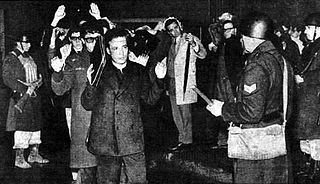
La Noche de los Bastones Largos was the violent dislodging of students and teachers from five academic faculties of the University of Buenos Aires (UBA), by the Federal Argentine Police, on July 29, 1966. The academic faculties had been occupied by the students, professors, and graduates who opposed the political intervention by the military government of General Juan Carlos Onganía to unilaterally revoke the academic freedom established in the 1918 university reform.
Miguel Ángel Virasoro was an Argentine mathematician and theoretical physicist. Virasoro worked in Argentina, Israel, the United States, and France, but he spent most of his professional career in Italy at La Sapienza University of Rome. He shared a name with his father, the philosopher Miguel Ángel Virasoro. He was known for his foundational work in string theory, the study of spin glasses, and his research in other areas of mathematical and statistical physics. The Virasoro–Shapiro amplitude, the Virasoro algebra, the super Virasoro algebra, the Virasoro vertex operator algebra, the Virasoro group, the Virasoro conjecture, the Virasoro conformal block, and the Virasoro minimal model are all named after him.
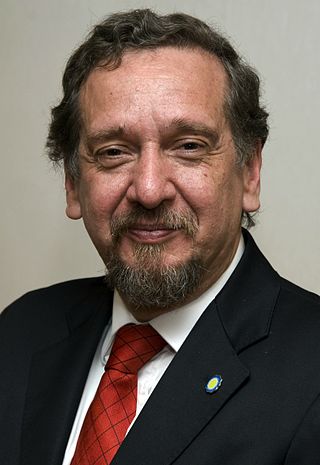
Lino Barañao is an Argentine chemist and politician. He was Minister of Science, Technology and Innovative Production of Argentina under President Mauricio Macri. He also served the same position under former president Cristina Fernández de Kirchner.
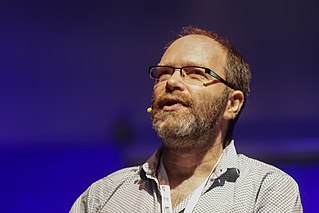
Diego Golombek is an Argentine biologist, communicator and popularizer of science. He is currently professor at National University of Quilmes and researcher at CONICET. He is author of several books about biology and related topics, although he is mainly known due to his appearances on radio and television.

Eduardo Arzt is an Argentine molecular biologist, Master in Experimental Biology, Doctor (Ph.D) from the Faculty of Pharmacy and Biochemistry. Currently, he is a senior researcher at CONICET, distinguished professor of the Faculty of Natural Sciences of the University of Buenos Aires, External Scientific Member of the Max Planck Society (Germany) and director of the Biomedicine Research Institute of Buenos Aires – CONICET – Partner Institute of the Max Planck Society.

Alicia Dickenstein is an Argentine mathematician known for her work on algebraic geometry, particularly toric geometry, tropical geometry, and their applications to biological systems. She is a full professor at the University of Buenos Aires, a 2019 Fellow of the American Mathematical Society, a former vice-president of the International Mathematical Union (2015–2018), and a 2015 recipient of The World Academy of Sciences prize.

The Bernardo Houssay Award is a distinction awarded by Argentina's Ministry of Science, Technology and Productive Innovation to honor outstanding work by scientists and researchers. The Ministry selects recipients annually through a jury of prominent scientists. Presented by the President of Argentina, it is one of the country's most prestigious prizes in the field of science and engineering.
Rebeca Cherep de Guber was an Argentine mathematician, university professor, textbook author, and 1960s pioneer in the development of computer science in Argentina.

María Antonia Ruth Sautu is an Argentine sociologist and methodologist.
Cristina Hemilse Mandrini is an Argentinian solar physicist. She is currently a researcher at the Argentinian National Council for Scientific and Technical Research (CONICET) and a professor at the University of Buenos Aires.

The Faculty of Social Sciences, commonly and informally known as Sociales, is the social sciences faculty of the University of Buenos Aires (UBA), the largest university in Argentina. It was founded in 1988, and offers degrees on social work, sociology, labor relations, communication and political science, in addition to a number of post-graduate degrees.

The Faculty of Medical Sciences, formerly and commonly known as the Faculty of Medicine, is the medical school of the University of Buenos Aires (UBA), the largest university in Argentina. Established in 1822 as one of the UBA's earliest divisions, FMED is presently the largest medical school in Argentina, with over 24,000 enrolled students as of 2011.

The Faculty of Economic Sciences, also simply known as Económicas, is a faculty of the University of Buenos Aires (UBA), the largest university in Argentina. Established in 1913 as the Instituto de Altos Estudios Comerciales, it is now the largest faculty within UBA, with over 36,000 grad students. The Faculty of Economic Sciences has the highest rate of international postgraduate students at 30 percent, in line with its reputation as a "top business school with significant international influence."

The Faculty of Pharmacy and Biochemistry is a faculty of the University of Buenos Aires (UBA), the largest university in Argentina. It was founded as an autonomous faculty in 1957, when it was split from the Faculty of Medical Sciences.

The Faculty of Engineering is a faculty of the University of Buenos Aires (UBA), the largest university in Argentina. It offers graduate courses on various fields of engineering, including civil engineering, computer science and engineering, mechanical engineering, electronic engineering, naval engineering, among others. It also offers graduate courses on system analysis, as well as post-graduate degrees on the magister, doctoral and post-doctoral levels.
Edelmira Inés Mórtola was the first woman to become a geologist in Argentina and the first woman to obtain a PhD in Natural Sciences with a focus on Geology (1921) from the University of Buenos Aires (UBA). She was a prominent researcher in the field of mineralogy and an influential university professor. The Mineralogy Museum at UBA was named after her.
References
- 1 2 "CURRICULUM VITAE OF JUAN PABLO PAZ" (PDF). 8 March 2010. Retrieved 19 January 2025.
- ↑ "Quantum Foundations and Information Buenos Aires". df.uba.ar. Retrieved 19 January 2025.
- ↑ "Decreto 17/2020: MINISTERIO DE CIENCIA, TECNOLOGÍA E INNOVACIÓN". Boletín Oficial de la República Argentina (in Spanish). 6 January 2020. Art. 7. Retrieved 19 January 2025.
- ↑ "Juan Pablo Paz: "Se cambió la lógica en la distribución de recursos científicos"". periferia.com.ar (in Spanish). 8 February 2023. Retrieved 19 January 2025.
- ↑ "Juan Pablo Paz". gf.org. Retrieved 19 January 2025.
- ↑ "2012 TWAS Prize winners announced". The World Academy of Sciences. 18 September 2012. Retrieved 19 January 2025.
- ↑ "Premio Houssay Trayectoria a Juan Pablo Paz" [The Houssay Trajectory Prize for Juan Pablo Paz]. uba.ar (in Spanish). Retrieved 19 January 2025.
- ↑ "Paz Juan Pablo". twas.org. Retrieved 19 January 2025.